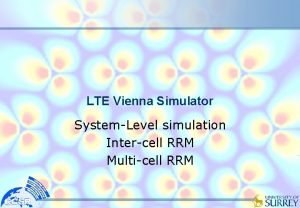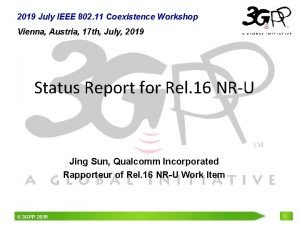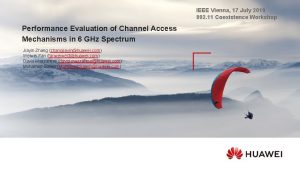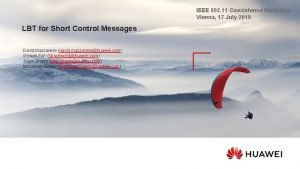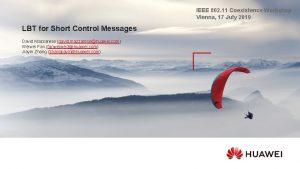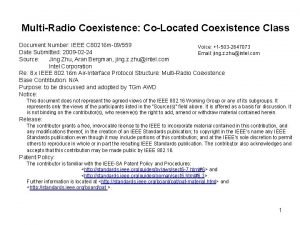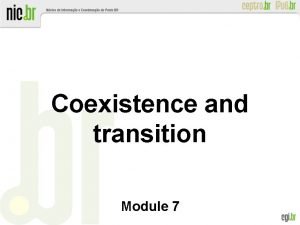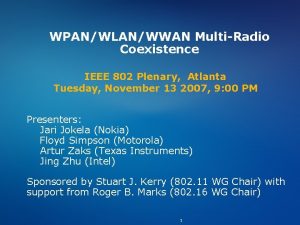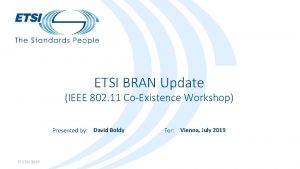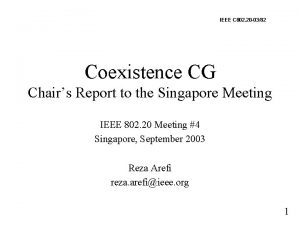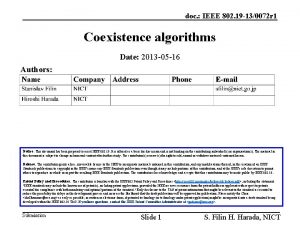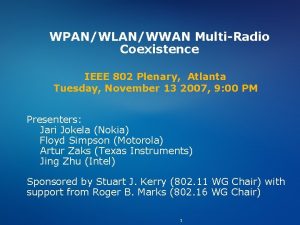IEEE Vienna 17 July 2019 802 11 Coexistence










![Evaluation results – indoor scenario [TR 38. 889] (1 spatial stream) 11 Evaluation results – indoor scenario [TR 38. 889] (1 spatial stream) 11](https://slidetodoc.com/presentation_image/2e824c009e6c2bab40d5034ce025b24a/image-11.jpg)
 12 Evaluation results – outdoor scenario 1 [TR 38. 889](1 spatial stream) 12](https://slidetodoc.com/presentation_image/2e824c009e6c2bab40d5034ce025b24a/image-12.jpg)
![Evaluation results – outdoor scenario 2 [TR 38. 889] (1 spatial stream) 13 Evaluation results – outdoor scenario 2 [TR 38. 889] (1 spatial stream) 13](https://slidetodoc.com/presentation_image/2e824c009e6c2bab40d5034ce025b24a/image-13.jpg)
![Evaluation results – indoor scenario [TR 38. 889] (<=4 spatial streams) 14 Evaluation results – indoor scenario [TR 38. 889] (<=4 spatial streams) 14](https://slidetodoc.com/presentation_image/2e824c009e6c2bab40d5034ce025b24a/image-14.jpg)
![Evaluation results – outdoor scenario 1 [TR 38. 889] (<=4 spatial streams) 15 Evaluation results – outdoor scenario 1 [TR 38. 889] (<=4 spatial streams) 15](https://slidetodoc.com/presentation_image/2e824c009e6c2bab40d5034ce025b24a/image-15.jpg)
![Evaluation results – outdoor scenario 2 [TR 38. 889] (<=4 spatial streams) 16 Evaluation results – outdoor scenario 2 [TR 38. 889] (<=4 spatial streams) 16](https://slidetodoc.com/presentation_image/2e824c009e6c2bab40d5034ce025b24a/image-16.jpg)
- Slides: 16

IEEE Vienna, 17 July 2019 802. 11 Coexistence Workshop Performance Evaluation of Channel Access Mechanisms in 6 GHz Spectrum Jiayin Zhang (zhangjiayin@huawei. com) Weiwei Fan (fanweiwei 3@huawei. com) David Mazzarese (david. mazzarese@huawei. com) Mohamed Salem (Mohamed. Salem@huawei. com)

Contents • Background • Potential Access Mechanisms in 20 MHz operation bandwidth • Evaluation assumptions, methodologies and results • Narrow band vs. Wideband LBT in 6 GHz • Conclusions

Background • There are discussions to open 6 GHz for unlicensed usage in both USA and EU > In FCC, the potential spectrum is from 5. 925 GHz to 7. 125 GHz, further divided into 4 bands of UN-II-5/6/7/8. > In ETSI, new WI on 5. 925 GHz to 6. 425 GHz was approved in June 2019 by TC BRAN (BRAN(19)102016 r 2). • The 6 GHz unlicensed spectrum attracted interests from both IEEE 802. 11 and 3 GPP NR-U > 3 GPP NR-U in Release 16 will support operations in 6 GHz (RAN 1 freeze at the end of 2019). > IEEE 802. 11 ax extended design of 5 GHz into 6 GHz. The testing in WFA (Wi. Fi 6) for 6 GHz is expected in Jan 2021. > IEEE 802. 11 be will also support 6 GHz spectrum in the future. • In 3 GPP NR-U Rel-16 Study item and Work Item > The coexistence between NR-U and 802. 11 ax in 6 GHz spectrum were evaluated by several companies. The schemes defined in 5 GHz were the starting points. > The support of wideband LBT (>20 MHz) as well as narrow band LBT (per 20 MHz) was also discussed to simplify the implementation. 3

Potential Access Mechanisms in 6 GHz • Baseline: (existing scheme for 5 GHz LAA) > Scheme 1: 11 ax PD=-82 d. Bm, ED=-62 d. Bm; NR-U ED only=-72 d. Bm • Common ED threshold between 802. 11 ax and NR-U > Scheme 2: 11 ax PD=-82 d. Bm, ED=-82 d. Bm; NRU ED only=-82 d. Bm > Scheme 3: 11 ax PD=-82 d. Bm, ED=-72 d. Bm; NRU ED only=-72 d. Bm > Scheme 4: 11 ax PD=-82 d. Bm, ED=-62 d. Bm; NRU ED only=-62 d. Bm • Common preamble : > Scheme 5: - Common 11 a preamble (L-STF+L-LTF+L-SIG); - 11 ax/NRU PD=-82 d. Bm, ED=-62 d. Bm; - assuming – 4 d. B detection SINR of 11 a preamble > Scheme 6: - Common 11 ax preamble (L-STF+L-LTF+L-SIG+RL-SIG); - 11 ax/NRU PD=-82 d. Bm, ED=-62 d. Bm; - assuming – 7 d. B detection SINR of 11 ax preamble without auto-detection. 4

Evaluation assumptions and methodology in TR 38. 889 Common configurations Indoor scenario Carrier Frequency Carrier Channel Bandwidth Number of carriers Number of users per operator Channel Model BS/AP Tx Power UE/STA Tx Power BS/AP Antenna gain UE/STA Antenna gain BS/AP Noise Figure UE/STA Receiver Noise Figure UE receiver MIMO BS/AP antenna Array configuration UE/STA antenna Array configuration outdoor scenario 1/2 Traffic model Numerology MCOT/TXOP Response timing Max MCS Other 5 6 GHz 20 MHz baseline 1 Exactly 5 per g. NB per 20 MHz Indoor: NR In. H Mixed Office model for all links Outdoor: NR UMi street canyon for all links 23 d. Bm (total across all TX antennas) 18 d. Bm (total across all TX antennas) 0 d. Bi 5 d. B 9 d. B MMSE-IRC DL/UL MU MIMO + DL/UL OFDMA, ideal CSI/CQI feedback (M, N, P, Mg, Ng) = (1, 2, 2, 1, 1), d. H = d. V = 0. 5 λ Tx/Rx: (M, N, P, Mg, Ng) = (1, 1, 2, 1, 1), d. H = d. V = 0. 5 λ Use 36. 889 Table A. 1. 1. Note: Results based on the mixed traffic models can be used to determine the design. system specific configurations NR-U 802. 11 ax 60 k. Hz SCS + ~1. 2 us CP 78. 125 k. Hz SCS + 0. 8 us CP 8 ms 4 ms K 1 >= 0. 75 ms, K 2 >= 0. 75 ms 16 us SIFS NR LDPC with 256 QAM 802. 11 ac/ax LDPC with 256 QAM CC-HARQ, 1 switching point within MPDU: 1500 B MSDU + 14 B header a COT. RTS/CTS off; NAV on MAC header

Performance comparison with common ED • When one of operator #2 replace Wi-Fi AP with NR-U g. NB, the UPT of remaining Wi-Fi operator (#1) increased when common ED threshold is adopted by both Wi-Fi and NR-U. • In most cases, adopting common ED threshold of -62 d. Bm between Wi-Fi and NR-U could achieve best performance of mean and 5 th percentile UPT. Gain of Wi-Fi OP#1 when OP#2 replacing Wi. Fi AP with NR-U g. NB Common ED=-82 d. Bm (scheme 2) Common ED=-72 d. Bm (scheme 3) Common ED=-62 d. Bm (scheme 4) Mean UPT (Wi-Fi in coex) 3. 4% 21. 4% 31. 8% 5% UPT(Wi-Fi in coex) 3. 1% 29. 9% 73. 4% • The NR-U performance could also benefit from the increased common ED threshold in most cases Gain of NRU OP#2 in coex with Wi-Fi OP#1 (compared with scheme 1) Common ED=-82 d. Bm (scheme 2) Common ED=-72 d. Bm (scheme 3) Common ED=-62 d. Bm (scheme 4) Mean UPT (NR-U in coex) -11. 6% 0. 9% 7. 2% 5% UPT(NR-U in coex) -30. 8% 2. 1% 7. 6% Note: DL performance with single stream, medium traffic load in indoor scenario 6

Performance comparison with common preamble • 11 ax performance is degraded due to less spatial reuse opportunities when all NR-U bursts are treated same as Wi-Fi using -82 d. Bm PD level. Gain of 11 ax by introducing common preamble to NRU 11 a preamble 11 ax preamble Compared with scheme 1 Compared with scheme 4 Mean UPT (Wi-Fi in coex) -17. 2% -18. 4% -16. 9% -18. 2% 5% UPT(Wi-Fi in coex) -26. 9% -40. 9% -24. 6% -39. 1% • NR-U performance is also degraded because of less spatial reuse (PD=-82 d. Bm for all burst) and limited detection sensitivity of 11 a and 11 ax preamble. Gain of NR-U by introducing common preamble to NRU 11 a preamble 11 ax preamble Compared with scheme 1 Compared with scheme 4 Mean UPT (Wi-Fi in coex) -13. 0% -18. 8% -12. 7% -18. 5% 5% UPT(Wi-Fi in coex) -34. 8% -39. 4% -30. 9% -35. 8% Note: DL performance with single stream, medium traffic load in indoor scenario 7

Narrow band vs. Wideband LBT in 6 GHz • NR-U Rel-16 supports component carrier of at most 100 MHz, as NR in Rel-15. Multiple such carriers (inter/intra band) can be aggregated. • The use of 320 MHz channel bandwidth is also under discussion in 802. 11 be for higher peak throughput. • Transmitter should perform LBT at each Observation Slot of 9 μs on each of 20 MHz operation channel, assuming similar multi-carrier channel access defined in 5 GHz (option 1 in ETSI 301 893, or type A in 3 GPP TS 37. 213). The complexity is quite high when the operation bandwidth is wide. • Simplification can be achieved, if option 2 in ETSI 301 893 or type B in 3 GPP TS 37. 213 is adopted, at the cost of limitation on the channel bonding patterns. • Wi-Fi performs ED on P 20/S 40/S 80 hierarchically when 160 MHz operating bandwidth is configured. • Wideband LBT could simplify the implementation of wideband operation when it can be guaranteed that the channel is free of narrow band interference. > limiting usage of narrow band signal (20 MHz) on certain sub-band > By long/short term measurement and LBT bandwidth adaption. > FFS: ED threshold 8

Conclusions • Common ED threshold (e. g. -62 d. Bm) can benefit both 802. 11 ax and NR-U due to additional spatial reuse gain. • A common preamble and PD/ED threshold, such 11 a preamble with PD=-82 d. Bm and ED=-62 d. Bm, degrades performance of both NR-U and Wi-Fi as it prohibits spatial reuse • Wideband LBT is beneficial for system operating with wide bandwidth to simplify LBT implementation. • IEEE and 3 GPP should explore the possibility to mandate a minimum bandwidth larger than 20 MHz in greenfield 6 GHz spectrum 9

Thank you. Bring digital to every person, home and organization for a fully connected, intelligent world. Copyright© 2018 Huawei Technologies Co. , Ltd. All Rights Reserved. The information in this document may contain predictive statements including, without limitation, statements regarding the future financial and operating results, future product portfolio, new technology, etc. There a number of factors that could cause actual results and developments to differ materially from those expressed or implied in the predictive statements. Therefore, such information is provided for reference purpose only and constitutes neither an offer nor an acceptance. Huawei may change the information at any time without notice.
![Evaluation results indoor scenario TR 38 889 1 spatial stream 11 Evaluation results – indoor scenario [TR 38. 889] (1 spatial stream) 11](https://slidetodoc.com/presentation_image/2e824c009e6c2bab40d5034ce025b24a/image-11.jpg)
Evaluation results – indoor scenario [TR 38. 889] (1 spatial stream) 11
 12](https://slidetodoc.com/presentation_image/2e824c009e6c2bab40d5034ce025b24a/image-12.jpg)
Evaluation results – outdoor scenario 1 [TR 38. 889](1 spatial stream) 12
![Evaluation results outdoor scenario 2 TR 38 889 1 spatial stream 13 Evaluation results – outdoor scenario 2 [TR 38. 889] (1 spatial stream) 13](https://slidetodoc.com/presentation_image/2e824c009e6c2bab40d5034ce025b24a/image-13.jpg)
Evaluation results – outdoor scenario 2 [TR 38. 889] (1 spatial stream) 13
![Evaluation results indoor scenario TR 38 889 4 spatial streams 14 Evaluation results – indoor scenario [TR 38. 889] (<=4 spatial streams) 14](https://slidetodoc.com/presentation_image/2e824c009e6c2bab40d5034ce025b24a/image-14.jpg)
Evaluation results – indoor scenario [TR 38. 889] (<=4 spatial streams) 14
![Evaluation results outdoor scenario 1 TR 38 889 4 spatial streams 15 Evaluation results – outdoor scenario 1 [TR 38. 889] (<=4 spatial streams) 15](https://slidetodoc.com/presentation_image/2e824c009e6c2bab40d5034ce025b24a/image-15.jpg)
Evaluation results – outdoor scenario 1 [TR 38. 889] (<=4 spatial streams) 15
![Evaluation results outdoor scenario 2 TR 38 889 4 spatial streams 16 Evaluation results – outdoor scenario 2 [TR 38. 889] (<=4 spatial streams) 16](https://slidetodoc.com/presentation_image/2e824c009e6c2bab40d5034ce025b24a/image-16.jpg)
Evaluation results – outdoor scenario 2 [TR 38. 889] (<=4 spatial streams) 16
 Bridges from 802.x to 802.y
Bridges from 802.x to 802.y Bridges from 802.x to 802.y
Bridges from 802.x to 802.y Coexistence
Coexistence Bittitan lotus notes to office 365
Bittitan lotus notes to office 365 Revolution of 1800 apush
Revolution of 1800 apush Bittitan coexistence
Bittitan coexistence The coexistence of good and evil
The coexistence of good and evil 802 15
802 15 Arquitetura ieee 802
Arquitetura ieee 802 El 802
El 802 Ieee 802 standard
Ieee 802 standard 802 ieee
802 ieee Ieee 802
Ieee 802 Ieee 802 family
Ieee 802 family Ieee 802 3 compliance
Ieee 802 3 compliance Ieee802.22
Ieee802.22 Congress of vienna simulation
Congress of vienna simulation
















